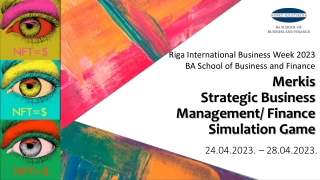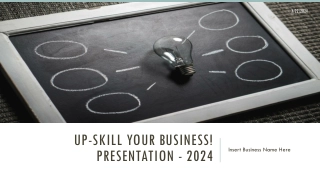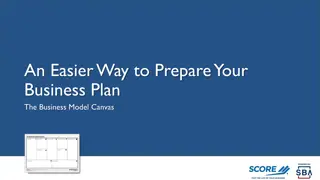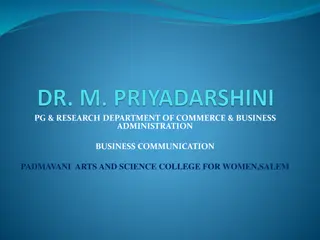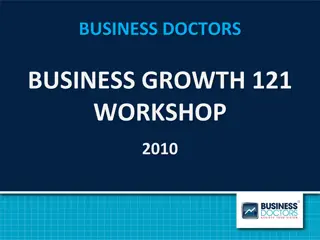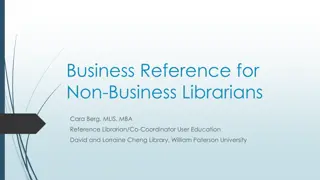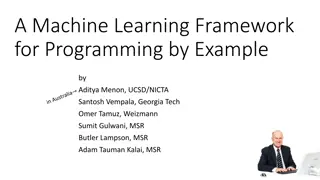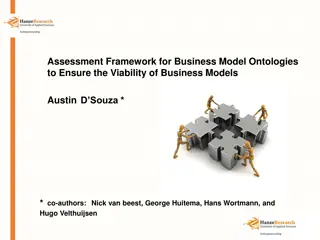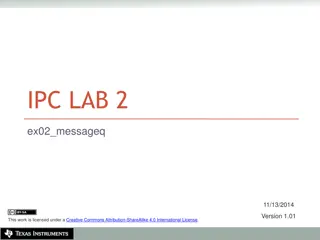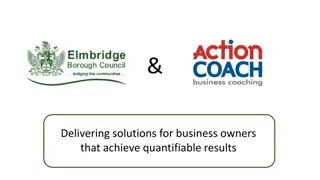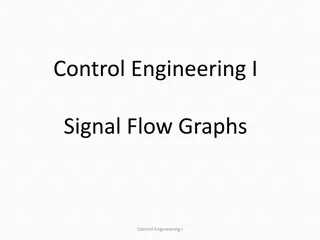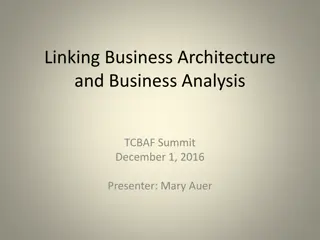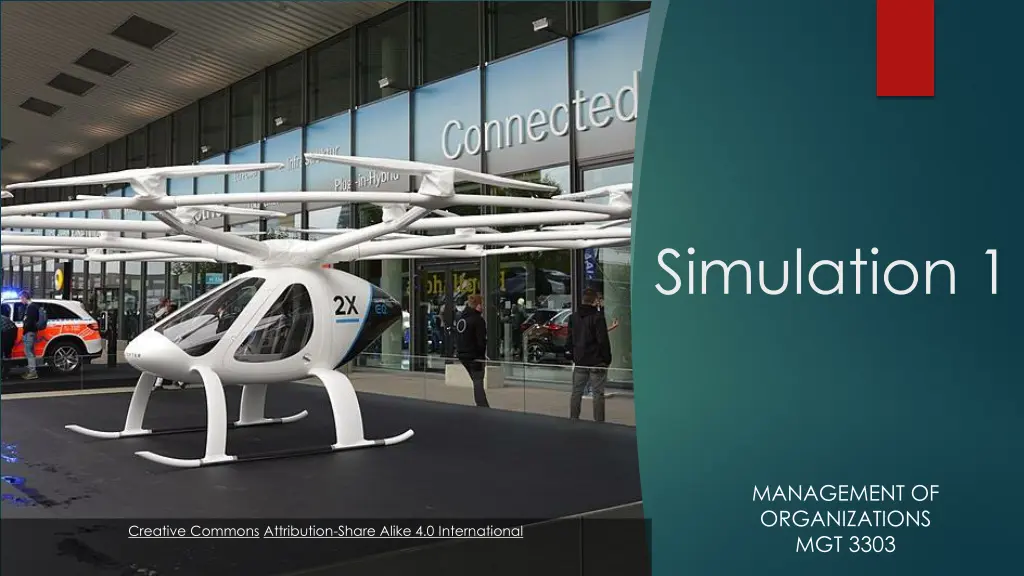
E-VTOLs in Urban Air Mobility Simulation
Dive into the realm of urban air mobility with a simulation on Electric Vertical Take-Off and Landing aircraft, exploring market opportunities, team objectives, and grading rubric criteria. Join groups, share insights, and propel your learning journey in this immersive experience.
Download Presentation

Please find below an Image/Link to download the presentation.
The content on the website is provided AS IS for your information and personal use only. It may not be sold, licensed, or shared on other websites without obtaining consent from the author. If you encounter any issues during the download, it is possible that the publisher has removed the file from their server.
You are allowed to download the files provided on this website for personal or commercial use, subject to the condition that they are used lawfully. All files are the property of their respective owners.
The content on the website is provided AS IS for your information and personal use only. It may not be sold, licensed, or shared on other websites without obtaining consent from the author.
E N D
Presentation Transcript
Simulation 1 MANAGEMENT OF ORGANIZATIONS MGT 3303 Creative Commons Attribution-Share Alike 4.0 International
What are E-VTOLs? Electric Vertical Take-Off and Landing aircraft take off and land like a helicopter. Also known as air taxis What s the Market Opportunity? global market projected to reach US$18 Billion by 2030 (47.5% CAGR from 2023 to 2030) What s Driving Growth? traffic congestion and need for efficient mobility in densely populated areas growing emphasis on sustainable, low-emission transportation advancements in electric propulsion, battery technology, and autonomous flight systems significant investment and interest from private companies, startups, and public authorities to develop urban air mobility ongoing development of regulatory frameworks for urban air mobility
Teams and Objectives Teams of 8-9 members Teams work together throughout semester on 4 simulations and a final team synthesis presentation Teams will take an EVTOL start up through its evolution by making decisions on strategy , planning, organizing, leading and controlling Team goal for each simulation: research issues, make recommendations, have a rationale for recommendations Teams will use Generative AI to do more thorough research and refine recommendations/rationale Teams present findings, recommendations on poster (more to come) Team graded as a whole, but team may decide to allocate points differentially among members participating in the workshop Team members not present for a workshop receive a zero grade. Team may recommend chronically non-participating member be terminated from team
Grading Rubric INSIGHT Does the team thoroughly research issue (within time allotted)? Does the team have clear point of view/recommendations? Are recommendations logical do arguments "hold together"? EVIDENCE Does team provide data and proof points to back up point of view/recommendations? Does team provide examples for recommendations; ie, "how it would work?" AI PROMPTS Does team develop quality prompts through careful construction and refinement?
What to Do Next Log in to Canvas course site Select "People" Click Groups tab Browse the list of groups Select group you want to join Click Join Important Things to Know Talk with others with whom you'd like to form a group, then pick a specific group and join A group is limited to 9 people; you cannot join a group that has hit that limit If you don't join a group by the deadline, you will be placed in one
Simulation 2: Creating a Strategic Plan MANAGEMENT OF ORGANIZATIONS | MGT 3303
Section: Team Number: Rationale Team Member Names Present In what markets should we be active? How do we get into those markets? How will we win in those markets (cost, service, technology, etc)? What should be our first steps to win? What are our target first year revenue & profit percent? How will we generate those results (low cost, premium price, etc)?
AI Prompts Topic Prompt(s)
AI as Your Business Co-Pilot A GUIDE
Why Use Generative AI? Increase Efficiency - help with baseline research and completing tasks Sharpen Critical Thinking through prompt creation & analytical thinking Boost Innovation through rapid idea generation Promote Ethical Decision Making bias awareness and data-driven decisions Build a competitive edge in the job market
Installing and Using Generative AI* *This example is for ChatGPT. If you use Gemini, CoPilot or other tools, the process is much the same Sign Up or Log In: Viisit ChatGPT's website. If you re new, click "Sign Up" and create an account using your email, Google, or Microsoft account. If you already have an account, click "Log In" and enter your credentials. Explore the Interface: Once logged in, you ll see a chat interface where you can type prompts. No need to install anything; it works directly in your browser. Start Writing Prompts: Begin by typing a specific question or directive related to your research topic. For example, "What are the best practices for managing remote teams in a global company?" Press "Enter" to submit the prompt. Review and Refine Responses: Read through the AI s response to see if it meets your needs. If the answer isn t quite right, you can refine your prompt by adding more details or asking follow-up questions. Use Information Responsibly: Remember to critically evaluate the AI s responses. Double-check facts and consider the context in which information is provided. Use the insights you gain as a starting point for deeper research. Ethical Considerations: Be mindful of ethical implications of AI-generated content. Consider biases and ensure information aligns with academic standards.
How to Create a Quality Prompt 1. Understand Problem a. Identify the Core Issue: Clearly define problem you're researching, such as employee retention or conflict resolution. b. Gather Background: Collect relevant background information to frame problem. Includes understanding industry, company size, and specific organization challenges. 2. Define Objective of Your Prompt a. Determine Specific Outcome: Decide what information or insights you want AI to provide whether it s strategies, case studies, best practices, or theoretical frameworks. b. Clarify Scope: Be clear whether prompt should focus on broad overview or specific aspect of problem. 3. Structure Your Prompt a. Start with Clear Question or Directive: Begin prompt with specific question or instruction, such as "What are effective strategies for improving employee engagement in large organizations?" b. Include Contextual Details: Add any necessary details, like industry, company size, or specific challenges (e.g., "in tech companies with over 500 employees"). c. Specify the Format: If needed, tell AI how to structure response, such as bullet points, pros and cons, or step-by-step guide.
How to Create a Quality Prompt (Cont) 4. Iterate and Refine Your Prompt a. Test and Review: Run prompt and review output. Assess whether results are relevant and actionable. b. Refine for Clarity: Based on initial results, refine prompt by adding or removing details as necessary. 5. Consider Ethical Implications a. Be Aware of Bias and Fairness: Pay attention to potential biases in AI responses, especially in areas like hiring practices, diversity, and inclusion. b. Protect Data Privacy: Ensure you re not including sensitive information when framing prompt. 6. Use Examples for Practice a. Review Sample Prompts: Look at examples of well-constructed prompts to understand best practices. b. Experiment: Practice creating multiple prompts on same topic to see how variations affect AI responses. 7. Evaluate and Reflect a. Assess the Quality of the Response: Critically evaluate AI-generated content for accuracy, relevance, and comprehensiveness. b. Reflect on Your Process: Think about what worked well and what could be improved in future inquiries.
Example of High-Quality Prompt Prompt: "What are the most effective strategies for improving employee retention in mid- sized tech companies with a high turnover rate, particularly among software developers? Provide examples from companies that have successfully implemented these strategies, and outline the key challenges they faced and how they overcame them." Why This Prompt Is High-Quality: 1. Specific and Clear: clearly defines problem employee retention in mid-sized tech companies, with focus on software developers. 2. Contextual Details: includes details about company size and specific issue of high turnover. 3. Desired Outcome: prompt asks for strategies, examples, and discussion of challenges and solutions, making it clear what is needed. 4. Comprehensive: By asking for examples and challenges, prompt encourages a well-rounded response that provides practical insights.




